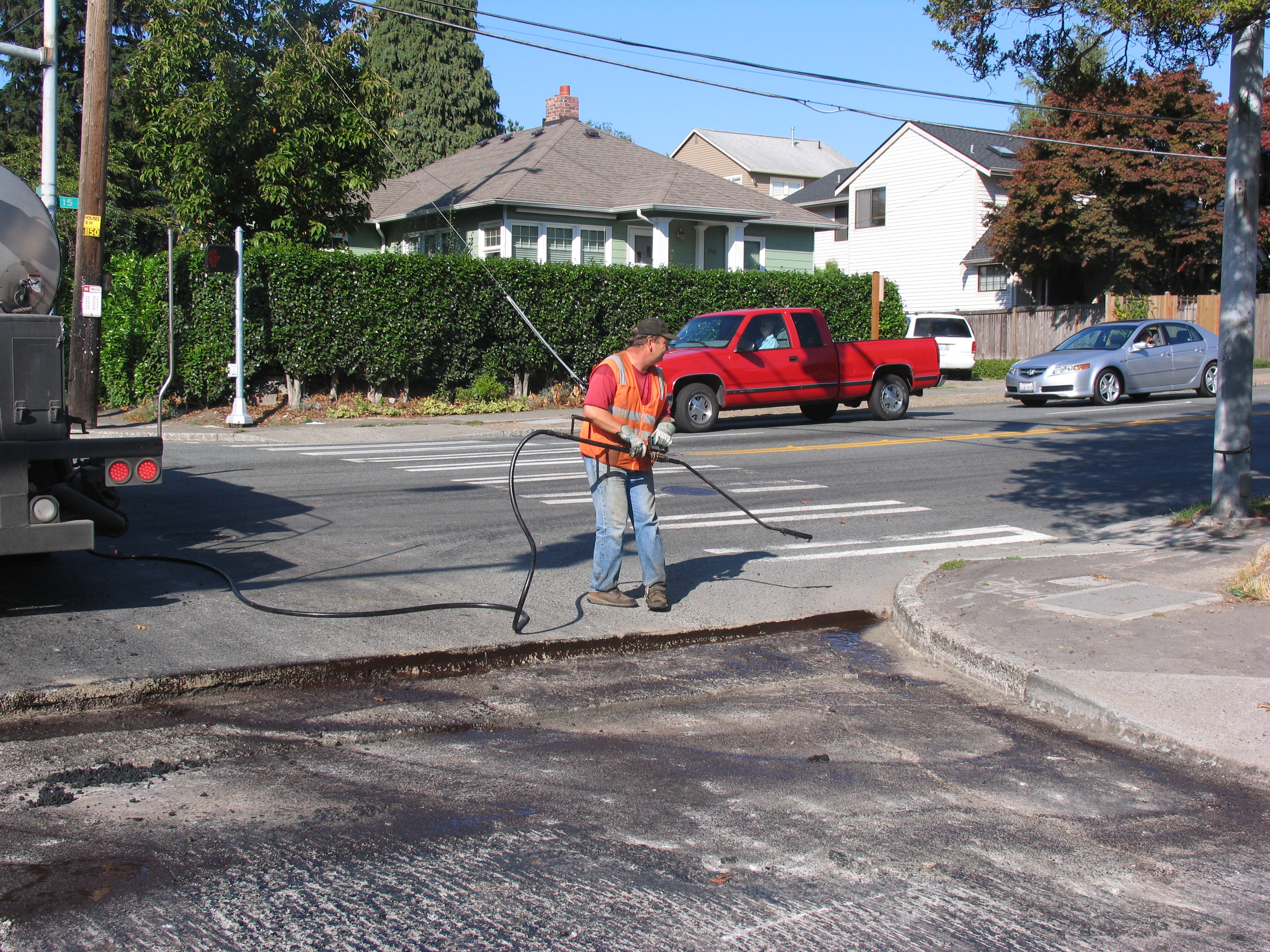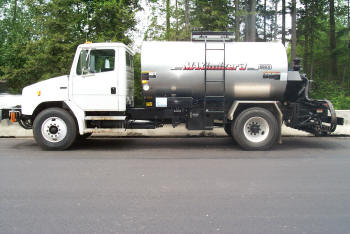Say you’re ordering a sandwich for lunch. The menu offers options like pastrami on rye or ham and cheese on sourdough, and you’re trying to make up your mind which you like best. But how much do you think about what goes in between those ingredients – will it be mayonnaise or mustard? Maybe you want something particular like horseradish or chipotle sauce. It can make a big difference in how your meal turns out. Like in the sandwich, the stuff that goes in between the layers of an asphalt pavement is also pretty important. In this edition of the RoadReady newsletter, we’ll take a closer look at one of those “ingredients” in a pavement structure, the tack coat.
Prior to placing a layer of asphalt pavement, a tack coat is commonly applied to the existing surface so that the new asphalt layer can bond with the layer underneath. The most commonly used tack coat materials are emulsions, or mixtures of asphalt and water. Other possibilities used less frequently include undiluted asphalt binder as well as cutback asphalt, where the binder is mixed with solvents.
Preparation and Use
Tack coat should be applied to a clean, dry surface. If an existing layer has been milled, or if dust is present for some other reason, the surface should be swept prior to tack coat application. The tack coat material is typically placed by a tack truck or asphalt distributor. In some spots, the material may also need to be applied manually, such as at joint faces. The tack coat should create a uniform coating of the existing surface, just like you probably want whatever condiment sauce you chose spread evenly on the bread in your sandwich.

Tack coat is sticky, and this adhesion is needed to help with the bonds between pavement layers. However, it also means that traffic should be kept off the surface until excess liquid has evaporated and the tack coat has set, because vehicle tires will tend to pick up and remove some of the asphalt. The next layer of asphalt pavement can be placed almost immediately after the tack coat, but care should be taken to ensure that the haul trucks do not cause tracking and pickup in the tack. Using a material transfer vehicle is one way to minimize this problem. Another approach sometimes used, especially in Europe, is to have a special paver outfitted with a spray bar that can apply the tack coat directly ahead of the screed.
Application Rate
A critical consideration with tack coats is selecting an appropriate application rate. If too little tack coat is applied, it will not be able to establish a proper bond between pavement layers. On the other hand, too much tack coat material can cause the layers to start slipping over each other – sort of like a pickle you just can’t keep from sliding out of your sandwich at lunch.

To achieve a proper bond, the application rate depends partly on the material being used and partly on the condition of the surface to which it is being applied. The purpose of the application rate is to leave a certain thickness of residual asphalt binder on the surface. This means that with respect to the material, the application rate is affected by the asphalt content of the material. The residual and the application rate would be the same if you are using straight asphalt binder, but for emulsions you need to factor in the ratio of asphalt to water in the emulsion. For example, if your specification calls for a residual application rate of 0.1 gallons per square yard and you have an emulsion that is 50% water, you need to apply the tack coat at a rate of 0.2 gallons per square yard to meet the target.
The existing surface affects the appropriate application rate based on the age and condition of the surface. Rough surfaces mean that there is significantly more exposed area that can absorb the tack coat and needs to be covered. Thus higher application rates are needed for milled surfaces because some of the tack will slip into the grooves created by milling the pavement. Placing tack coat on an existing pavement prior to an overlay requires a somewhat lower application rate, but still more than you would use between two fresh asphalt layers when constructing a new pavement.
Evaluation and Testing
Tack coats are critical because they help prevent delamination, which occurs when pieces of asphalt pavement come loose and separate from the rest of the structure. However, during construction the evaluation of tack coat performance is often neglected. A basic level of quality control may be used, typically involving a visual check that the tack creates a smooth, uniform coating and that the application rate appears to be as desired. Actual testing of the strength of the tack coat bond is less common, but could be quite useful to help better determine the appropriate material and application rate to use.

The Louisiana Transportation Research Center (LTRC) conducted a study of different tack coat evaluation methods (see NCHRP link below). Based on this research, the LTRC devised a test procedure that can be used to evaluate how well the tack coat will bond in terms of shear strength and tensile strength. The procedure involves placing a metal plate on a sample of tack coat material on the existing surface, applying a load to the plate, then measuring the force required to remove the plate. This type of pull-off test means that tack coat bonding properties can be evaluated in the field, not just by taking a core sample (after the next layer has been placed) and testing it in the lab.
Keeping the Pavement Together
A tack coat literally acts as a kind of glue that holds the layers of an asphalt pavement structure together. Sometimes it may get treated as an afterthought, but it’s an essential ingredient and should be properly and thoroughly applied. Tack coat may not be quite as delicious as a good sandwich, but the satisfaction it provides through a quality pavement will last a lot longer!
Additional Links
National Cooperative Highway Research Program, Report 712, Optimization of Tack Coat for HMA Placement: http://onlinepubs.trb.org/onlinepubs/nchrp/nchrp_rpt_712.pdf
Flexible Pavements of Ohio, Technical Bulletin: Proper Tack Coat Application: http://www.flexiblepavements.org/sites/www.flexiblepavements.org/files/tack_coat_tech_bulletin_19sept2012.pdf


What is the current/immediate future availability of spray pavers, and are they feasible to use on city resurfacing projects; i.e. is some sort of material transfer necessary for the tack coat material ?
Kerry, we purchased a new spray paver a couple of years ago. 1 advantage is that the asphalt haulage trucks do not remove the tack when driving in & out of the jobsite. It is not used often due to Australian local authorities not being able to provide large areas , which is essential for this machine. For large highway work it is fantastic.
Spray pavers are available commercially and some agencies use them in the U.S. as well, not just Europe. Utah DOT has a helpful technical bulletin on the subject. The tack material is typically provided via an additional tank built onto the paver. As far as feasibility, what’s the best option for a particular project will depend on your needs and budget, but a spray paver certainly could be considered alongside other alternatives.
How would a spray paver work if the standard specifications require that the tack coat has “broken” prior to placing HMA?
A spray paver might need a special provision if the standard specification requires the tack coat to break prior to placement. Using a spray bar would eliminate the biggest problem, which is tracking in the fresh tack. The remaining concern is whether the tack coat will bond properly to the new asphalt layer, but it should be possible. The heat of the fresh mix will accelerate the evaporation of water in the tack, so that it effectively “breaks” as the new material is being placed on it.
In reply to Scott”The heat of the fresh mix will accelerate the evaporation of water in the tack’is there sufficient time to evaporate water from tack during laying of asphalt?